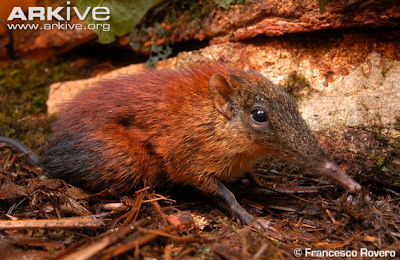Dear Readers,
Thank you so much for stopping by again. This week we are
going to meet a very unusual little creature. It’s called the Grey-Faced Sengi.
The Grey-Faced Sengi is a particular species of Elephant Shrew. Prior to 2005
there were only fifteen species of Elephant Shrew. Now, with the discovery of
the Grey-Faced Sengi, there are sixteen species.
In 2005 this little shrew was captured on camera, but it
wasn’t until 2008 that its discovery was actually announced. The Grey-Faced
Sengi is larger and has a different colored coat than other elephant shrews. It
can grow to about twenty-two inches in length and weigh about a pound and a
half.
As we said, this particular specie of elephant shrew is
larger than other shrews, but it is similar in many other ways. First, all
elephant shrews have that long trunk-like snout. That’s how they got their
name. The end of their snout has no fur on it, and it is black. Also, like
other shrews, the Grey-Faced Sengi is diurnal.
Diurnal means that he hunts for his food during the day. They really like all
kinds of invertebrates –
insects! They have long legs, like an
antelope and a tail like a rat. The long legs give them the ability to sprint,
and the tail gives them balance. I know
that this is going to sound really strange, but the Grey-Faced Sengi, along
with all the other elephant shrews, is more closely related to the Elephant
than it is to shrews. Now there’s an odd fact that you can share!
The Grey-Faced Sengi lives on the continent of Africa in a country call Tanzania. Specifically, it lives in the
forests in the Undzungwa Mountains of south central Tanzania.
The Grey-Faced Sengi is threatened. According to the IUCN*,
an animal is considered threatened if it is one of three things. Those three
things are:
1.
Vulnerable - VU
2.
Endangered
- EN
3.
Critically Endangered - CR
Each of the above three categories have a very specific
definition assigned by the IUCN. The below information is taken directly from
the IUCN Web Site - http://www.iucnredlist.org
CRITICALLY
ENDANGERED (CR) - A taxon
is Critically Endangered when it is facing an extremely high risk of extinction
in the wild in the immediate future, as defined by any of the criteria (A to E)
as described below.
ENDANGERED
(EN) - A taxon is
Endangered when it is not Critically Endangered but is facing a very high risk
of extinction in the wild in the near future, as defined by any of the criteria
(A to E) as described below.
VULNERABLE (VU) - A taxon is Vulnerable when it is not
Critically Endangered or Endangered but is facing a high risk of extinction in
the wild in the medium-term future, as defined by any of the criteria (A to E)
as described below.
The Grey-Faced Sengi, is vulnerable. The greatest threat to this
specie of shrew is man. Human populations are expanding, and as a result, there
is pressure on the environment of this shrew. The forests that the Grey-Faced
Sengi lives in are dwindling because of human encroachment. It is also thought
that local tribes hunt the shrew for food, but that has not been proven.
Photo Credit:
BBC
I have found a super video for you. In this video you will see the smaller specie of Elephant Shrew from east Africa, but as we have said above, these shrews all of the similar characteristics and behaviors. You’ll even get a chance to see
how fast they are – because they need to be.
If you have questions, please feel free to leave it in the
comments section. I love hearing from you.
My thanks to ARKive.org and BBC (see link below) for the pictures and video.
Here are a few more sites for you to explore for more
information.
*IUCN = International Union for Conservation of Nature and Natural Resources
Enjoy!
J.E. Rogers




No comments:
Post a Comment